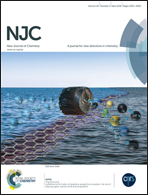Highly efficient removal of TiO2 nanoparticles from aquatic bodies by silica microsphere impregnated Ca-alginate†
Abstract
A novel material, “calcium-alginate–silica microsphere” (Cal-Alg–SM) beads, was developed by impregnating silica microspheres in calcium alginate. These beads were highly efficient in the removal of TiO2 nanoparticles from aquatic bodies without disturbing their physicochemical characteristics. The optimum composition of the beads was 10% loading of silica microspheres into a 4% Ca-alginate matrix. They were formed by the controlled addition of a homogenised mixture of SMs and Na-alginate solution into 0.4 M CaCl2 solution. Cal-Alg–SM beads were characterized by measuring zeta potential, recording Fourier Transform infrared spectra and scanning electron microscopy coupled with energy dispersive spectrometry mapping both before and after the uptake. Uptake studies carried out in batch mode showed that Cal-Alg–SM beads are very effective for the removal of TiO2 nanoparticles in the pH range of 3–5 and the sorption was more than 90% in the concentration range of 10–500 μg mL−1. Beads were successfully tested with lake and groundwater samples spiked with TiO2 nanoparticles. The sorption isotherm was seen to follow the Langmuir model and the uptake capacity evaluated was 29.9 mg g−1. The mechanism of sorption was proposed based on the zeta potential values of SMs and TiO2 nanoparticles at different pH values.


 Please wait while we load your content...
Please wait while we load your content...